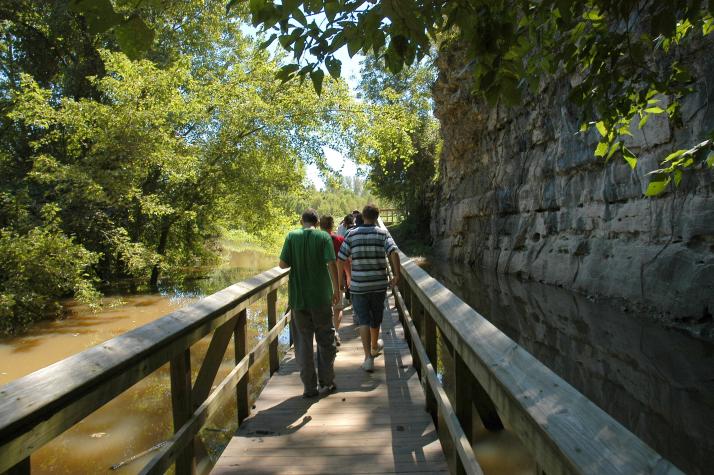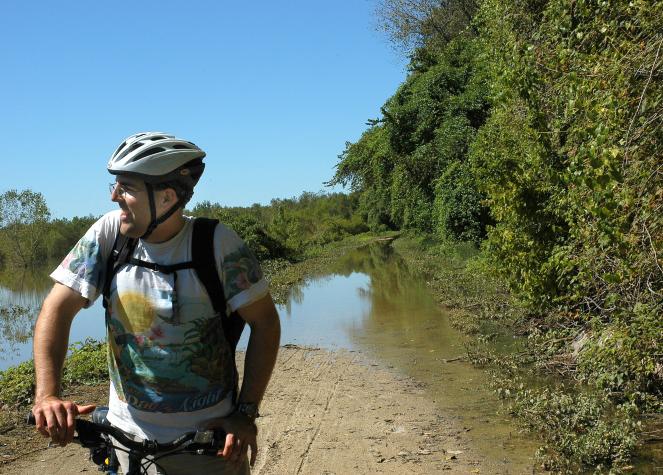COLUMBIA, Mo. - Students at Frederick Douglass High School in Columbia are learning about the Missouri River and its history through a series of field trips and activities developed by their teachers in collaboration with researchers from the University of Missouri School of Natural Resources.
Funded by a grant from the National Fish and Wildlife Foundation, the Corps of Discovery project enhances classroom learning through field trips, service-learning projects and interactions with conservation and wildlife professionals. Most of the activities take place at Overton Bottoms, a unit of the Big Muddy National Wildlife Refuge, which is operated by the U.S. Fish and Wildlife Service.
"We want students to learn more about the social, cultural and environmental history of the Missouri River; improve their awareness, understanding and appreciation of the Big Muddy; and help them explore some career opportunities in natural resource management," said Mark Morgan, associate professor in MU's Department of Parks, Recreation and Tourism. "We feel that active involvement would be a better way to learn this information, as compared with using a traditional classroom approach."
Big Muddy NWR occupies 10,000 acres in eight sites along the Missouri River floodplain. While rich in history and endowed with a diversity of plant and animal life, the refuge remains little-known, Morgan said.
"Although the refuge is charged with a responsibility to provide outdoor recreation and environmental education, it has limited staff and financial resources," Morgan said. "Bringing students to the refuge is a benefit to the students and the Fish and Wildlife Service."
Douglass High School, an alternative public school with fewer than 200 students, provides a non-traditional curriculum tailored to at-risk students.
"Due to barriers and constraints, some disadvantaged students, especially minorities, have fewer opportunities for field trips than those attending other high schools in Columbia," Morgan said. "We wanted to make sure that these students received the same opportunities as others in the district."
Graduate student Bryan Danford worked with Morgan and Charlie Nilon, an MU fisheries and wildlife professor, to develop a curriculum model for two courses, environmental studies and cultural studies. Teachers Angela Waller and John Reid built on this work, incorporating their own knowledge and experience as teachers and nature enthusiasts in the design of their courses.
Waller's cultural studies class covers Missouri River history through such topics as the Lewis and Clark expedition and American Indians of mid-Missouri, while Reid's course on environmental studies uses the Missouri River and Overland Bottoms to explore subjects such as water and nutrient cycles, plant and animal habitats, pollution, recycling and the role of fires and floods in ecological succession.
Through the field trips and service-learning projects, students gain firsthand experience with many of the concepts discussed in the classroom. For example, a trip to the Diana Bend Conservation Area, across the river from Overland Bottoms, provided students an opportunity to walk in the footsteps of Lewis and Clark, see an Indian burial mound and taste native edible plants (for those who dared). Brian Flowers, outdoor skills specialist for the Missouri Department of Conservation, discussed how ancient glaciers shaped the local geology, while students could see for themselves how recent rainfall had flooded stretches of the Katy Trail.
Activities during the fall semester included planting native grasses to replace invasive plant species at Overland Bottoms and studying water quality by testing samples for nutrients, pH and turbidity.
"This project has given our students real-world experiences that we can build on in the classroom," Waller said. "We aren't just offering notes or pictures from a projector. They have memories and experiences to help them connect and process new information."
Reid said the project has more than just academic benefits. "This is building self-confidence in students by challenging them to push beyond their comfort zones," he said. "It's also giving them the opportunity to enjoy healthy outdoor activities that I hope will continue throughout their lives."


